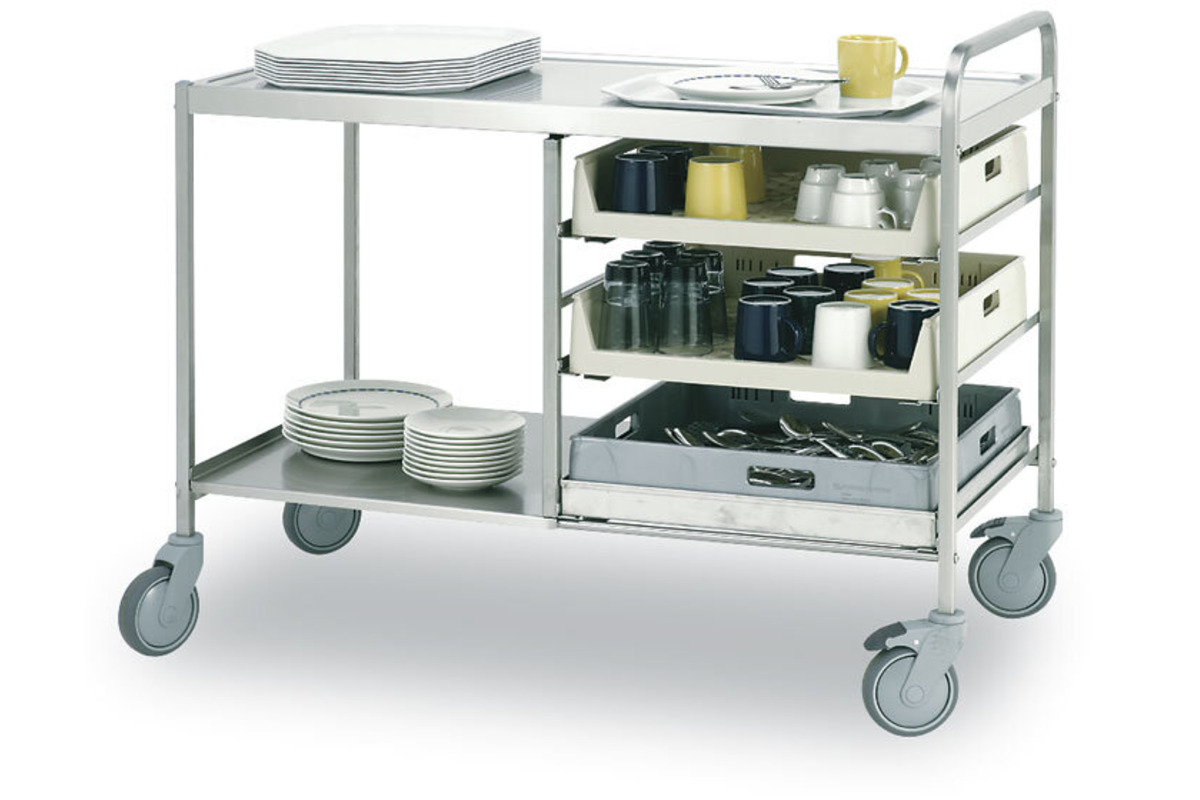Introduction to Afruimwagens
If you’re hearing the term “Afruimwagens” for the first time, you might be wondering what it actually means. The word comes from Dutch and literally means “collection cart.” In practice, Afruimwagens are special carts used in the food service, catering, and cleaning industries to efficiently and hygienically retrieve plates, glasses, cutlery, or other items. If you’ve ever observed staff transporting plates or trays in a busy restaurant or hotel, chances are they’ve used a collection cart.
These Afruimwagens may look simple, but they play a surprisingly important role in ensuring a smooth workflow. Without them, servers would take twice as long to travel from the dining room to the kitchen and back. Hotels and conference centers would struggle to maintain order at their events. Even healthcare facilities benefit from them, as they quickly retrieve and transport used equipment or trays from patient rooms. In other words, Afruimwagens are the unsung heroes of logistics in the service sector.
As the restaurant and hospitality industry evolves, the design and functionality of these trolleys are also changing. Fruit trolleys now come in a variety of shapes, sizes, and materials, each suited for a specific purpose. Some are compact and lightweight, while others are robust and designed for heavy-duty use. And although they look like simple trolleys, they are carefully constructed to meet hygiene standards, safety regulations, and ease of use.
Purpose and Importance of Afruimwagens
At first glance, it may seem that fruit trolleys simply transport dirty dishes. While this is undoubtedly their most obvious function, the importance of these trolleys is much greater. They contribute subtly but effectively to efficiency, hygiene, and even customer satisfaction.
Efficiency is the most important factor. In a busy restaurant, waiters’ capacity is limited. Without trolleys, cleaning even a medium-sized table would require multiple trips, wasting time waiting for new guests. Fruit trolleys allow staff to clean tables more quickly, resulting in faster seating changes. For restaurants, this immediately translates to increased revenue potential, as they can serve more guests during peak times.
Another important aspect is hygiene. Fruit Afruimwagens carts have smooth surfaces, often made of stainless steel or durable plastic, making them easy to disinfect. This is crucial because they hold used plates, leftover food, and dirty glasses. Because these carts store everything safely and are easy to transport, they reduce the risk of contamination in food service areas. In facilities like hospitals, they also help ensure that used trays or medical instruments are transported hygienically and safely.
Finally, there is the customer experience. Most guests probably don’t pay attention to whether a cart is being used, but they will certainly notice if a table is left untidy for too long. A quick cleanup keeps the dining room organized and makes it more pleasant for everyone. Thus, fruit carts help maintain the overall atmosphere and flow of a food service area, even while working in the background.
Types of Afruimwagens
Not all Afruimwagens are the same. Depending on the type of business and its specific requirements, there are a variety of cart designs on the market. Knowing the differences can be crucial when choosing the right cart for your company.
The most common type is the multi-tiered cart. Afruimwagens typically have two to four levels of shelves, allowing staff to neatly stack plates, trays, or glasses. They are popular in restaurants, hotels, and conference centers because they maximize load capacity without being too bulky. Some Afruimwagens even have removable containers for cutlery or leftover food, making pickup even easier.
Another variation is the tray cart. These are commonly used in cafeterias, school cafeterias, or self-service canteens. Customers place their trays directly into the designated compartments, and the cart can be easily returned to the kitchen. This type of cart focuses on convenience and speed, reducing staff workload by encouraging customers to participate in the pickup process.
There are also special pickup carts designed for specific environments. In healthcare, for example, you can find carts specifically designed for transporting patient trays. For large catering events, heavy-duty carts are designed to carry large quantities without tipping or breaking. Some modern Afruimwagens are even equipped with sound-dampening casters and shock absorbers, ensuring quiet and smooth movement on various floor surfaces.
Material and Design Considerations
The durability and usability of a serving cart depend largely on the materials it is made from. The two most common materials are stainless steel and high-quality plastic, each with its own advantages.
Stainless steel serving Afruimwagens are the gold standard in professional kitchens and fine dining establishments. They are robust, durable, and corrosion-resistant. Their sleek metal look also fits perfectly into modern interiors. However, they tend to be heavier, which may not be ideal in areas where carts must be frequently moved long distances.
Plastic Afruimwagens, on the other hand, are lighter and often more economical. They are ideal for environments where mobility is crucial, such as school cafeterias or cozy dining halls. Modern plastics are extremely durable, scratch-resistant, and easy to clean. Some are even available in attractive designs or colors, making them a better fit for certain interior styles.
In addition to the material, design is also crucial. Features such as ergonomic handles, locking casters, and quiet wheels may seem like minor details, but they significantly impact daily use. Safety is also important: Sharp edges or poorly balanced Afruimwagens can pose a hazard to both employees and customers. For businesses, investing in a well-designed cart means fewer accidents, smoother workflows, and a longer service life for equipment.
Where Afruimwagens Are Used
Afruimwagens are most commonly associated with restaurants, but their uses extend far beyond that. In fact, they are used in areas where efficient pickup, transportation, and organization of items are required.
In restaurants and hotels, their role is obvious. They are used for clearing tables, transporting used dishes to the dishwashing area, and returning clean dishes to the service counter. In larger hotels, they also play a role in room service, where they assist with transporting meals or discreetly collecting used trays.
African trolleys are indispensable in the healthcare sector. Hospitals and nursing homes rely on them to distribute meals to patients and then efficiently collect the trays. Because hygiene is a top priority, the trolleys used in healthcare are often designed to be extremely easy to clean and sterilize.
In corporate and event settings, such as conference rooms, African trolleys help staff manage large crowds. Imagine a corporate dinner for 500 people: Without trolleys, the logistics of Afruimwagens collection and cleanup would be a nightmare. They are also widely used in schools, cafeterias, and even manufacturing facilities, where they are used to transport tools, parts, or consumables. Their versatility makes them an indispensable part of many industries beyond the hotel industry.
Benefits of Afruimwagens
So why should a company invest in high-quality fruit carts instead of relying on manual cleaning methods? The advantages are numerous and benefit both employees and customers.
The biggest advantage is efficiency. With a well-designed cart, a single employee can complete the work of several people in half the time. This not only reduces labor costs but also allows employees to focus on customer service instead of logistics.
Another advantage is ergonomics and safety. Repetitively carrying heavy trays can lead to strain and injuries over time. By using fruit carts, employees can avoid bending, lifting, and excessive carrying. This reduces workplace accidents and increases overall job satisfaction.
Finally, there is the cost-benefit factor. While purchasing high-quality fruit carts requires an initial investment, it pays for itself over time. Longer-lasting carts mean less frequent replacement, while the associated efficiency leads to higher productivity and potentially higher revenue. In short, fruit trolleys are one of the tools that discreetly increase profitability.
How to Choose the Right Trolley
Choosing the right trolley isn’t just about the most cost-effective option. Also consider the size of your business, the type of environment, and the specific tasks you want to perform with the trolley.
For small restaurants or cafes, a compact, multi-tiered trolley is often sufficient. These establishments don’t have the same volume as large hotels, so maneuverability is more important than maximum capacity. Choosing a lightweight plastic trolley with quiet wheels makes cleaning easier in intimate spaces.
For large hotels, catering companies, or hospitals, durability and capacity are crucial. Multi-tiered or custom-made stainless steel trolleys are often more practical in these environments. Noise-reducing casters and sturdy handles are also important in these environments, as employees use the trolleys during long shifts and on varying floor types.
Again, it’s worth weighing budget against long-term value. Although plastic carts may seem inexpensive at first glance, they may need to be replaced sooner in heavily used environments. Choosing quality from the start often saves money in the long run. Also, check warranties, customer reviews, and the reliability of the supplier before purchasing.
Maintenance and Care Tips
Like any appliance, fruit carts require regular maintenance to stay in top condition. Fortunately, maintenance is generally minimal if a few best practices are followed.
First, cleaning is crucial. Since these carts often contain dirty dishes and food scraps, they should be disinfected daily. Use non-abrasive cleaners on stainless steel carts to maintain shine and prevent corrosion. For plastic carts, warm water and mild detergents are usually sufficient.
Second, wheel care is often neglected. The wheels or casters are the most susceptible parts to wear. Check them regularly for dirt, grease buildup, or looseness. Replacing wheels when they start to squeak or bind will extend the life of the entire cart. Finally, storage and handling are crucial. Don’t overload carts beyond their rated capacity, as this can cause them to bend or break. Store them in a dry place, especially if they’re made of metal, to prevent rust. With a little care, a good cart can last for years.
The Future of Afruimwagens
Like many other tools in the service sector, Afruim carts are evolving with technology. Manufacturers are exploring ways to incorporate smart features and sustainable materials into their designs.
Some companies are already experimenting with automated picking carts that follow employees or navigate spaces independently. These semi-robotic carts can further reduce manual effort, especially in large facilities like hotels or hospitals. Although they are still relatively new and expensive, they demonstrate the direction the industry is heading.
Sustainability is another trend. With growing awareness of eco-friendly practices, more and more companies are looking for carts made from recycled or sustainable materials. Manufacturers are also developing modular carts that can be easily repaired rather than replaced, reducing waste in the long run.
It’s safe to say that the humble Afruim cart isn’t going anywhere. As efficiency, hygiene, and sustainability become increasingly important in the service sector, these carts are likely to become even more advanced and indispensable.
Conclusion
Afruimwagens may not be the most eye-catching piece of equipment in a restaurant, hotel, or hospital, but they are indispensable. They ensure efficiency, hygiene, and professionalism in the service environment, facilitate the work of staff, and improve the customer experience. From simple multi-tiered serving trolleys to state-of-the-art, intelligent serving trolleys, they have evolved tremendously since their introduction.
Whether you’re organizing a small café, a hospital, or a large event, choosing the right Afruimwagens can make all the difference. Investing in quality, proper maintenance, and understanding their role in your workflows pays off in more ways than just time savings. Serving trolleys are one of the tools behind the scenes that ensure optimal operations.










